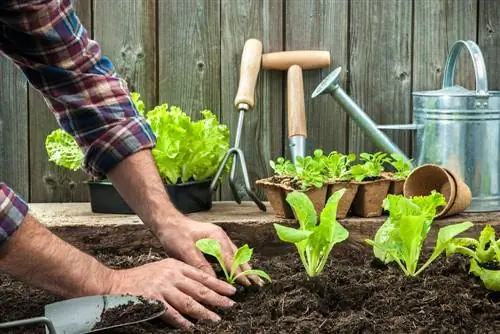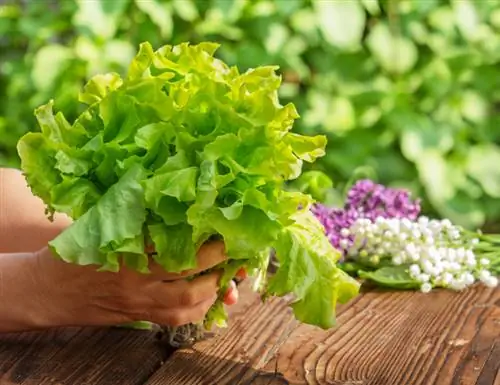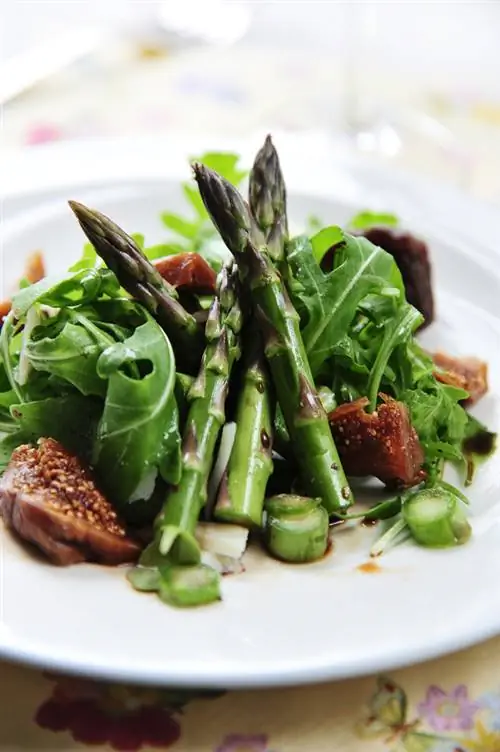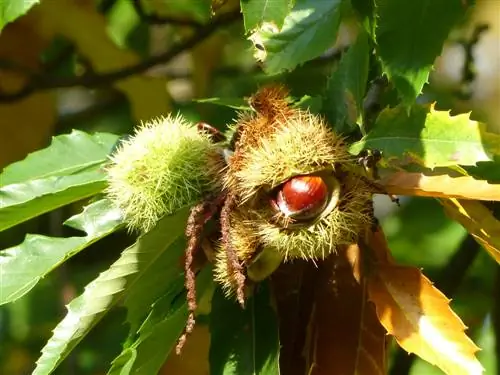- Author admin [email protected].
- Public 2023-12-16 16:46.
- Last modified 2025-06-01 06:02.
Freshly harvested salads are small vitamin bombs that offer a varied taste experience. In addition to traditional varieties such as lettuce, new varieties ensure variety in the salad bowl. Due to the short cultivation period of lettuces, this is guaranteed even if you only have a limited bed area.
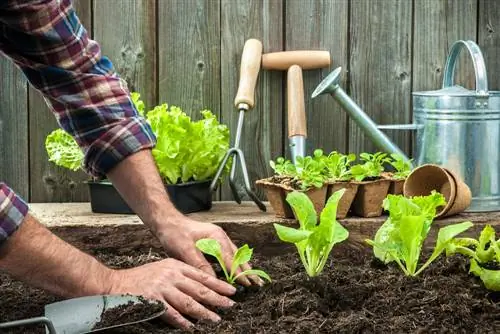
How to grow salads in June?
In June you can cultivate lettuces either through early seedlings from the garden supply store or by sowing them in the bed. For seedlings, look for strong, spot-free plants and plant them in the cooler morning or evening hours. Lettuces in beds should be sown at temperatures below 20 degrees.
Shortening culture time through seedlings
If you haven't sown lettuces in June, you can shorten the time until harvest by growing young plants from the gardening store. When planting, consider the following points so that the small plants develop well:
- When buying, look for strong seedlings with spot-free, crisp leaves.
- The wind must be able to blow through lettuce: only plant it deep enough that the root base is covered with a thin layer of substrate.
- The planting distance is around 30 centimeters for lettuce and lettuce. Plant endive and radicchio, on the other hand, about 40 centimeters apart.
- Since it can get quite warm during the day in June, you should plant the plants in the ground in the morning or evening.
- Unfortunately, snails especially love young lettuce plants. Therefore, pour individually. Since the ground between the seedlings remains dry, the reptiles avoid the freshly planted lettuce.
Sowing salads
You can sow salads until late summer, so it's not too late for the green vitamin bombs. When sown directly into the bed, lettuces form more and deeper roots. This means they don't shoot as quickly and produce inflorescences. They also need to be watered less. Since lettuces no longer germinate above 20 degrees, you should provide some shade on hot days or choose a cool phase for sowing.
Cultivating salads in the bucket
You can also grow salads in pots on the balcony or terrace, provided they are placed in a bright location. The planter does not have to be very large as only a few lettuce plants form deep roots. There is space for several heads of lettuce in a balcony box. The same applies here: Do not leave a planting distance of less than 25 - 30 centimeters.
You do not need to fertilize additionally because the nutrients contained in the substrate are sufficient. However, you should keep the lettuces evenly moist throughout the growing period and water them regularly. But don't overdo it, otherwise there is a risk of root rot.
Which variety is suitable?
Due to the large number of new breeds for a wide variety of requirements, this question cannot be answered in a general way. Get detailed advice from a specialist retailer. Old varieties such as sugar loaf or the almost forgotten dandelion salad, with its slightly bitter aroma, represent a taste experience.
What diseases and pests are threatening?
Salads are unfortunately occasionally eaten by:
- Downy mildew or
- Lettuce rot
infested. Resistant new varieties are a good alternative if you have ever had to struggle with these diseases in the vegetable patch.
You can keep away snails that graze all of the lettuce in a very short time using snail fences. Consistently collect animals in the bed. If you have the opportunity to release them far enough away from the house, you should not kill the reptiles for ecological reasons. Snail pellets (€9.00 on Amazon) with the active ingredient iron III phosphate are approved for organic cultivation and are very effective.
If aphids cause serious damage to lettuce, you should choose resistant new varieties. Rinsing with water is also helpful, as the animals that have been washed to the ground can no longer reach the lettuce plants.
Cutworms and rootworms are the larvae of various species of moths and butterflies that lay their eggs on the leaves of lettuce. The animals first feed above ground and then migrate into the ground, where they can cause massive damage to the roots. Cultural nets can be used to keep the butterflies away from the lettuce heads without having to interfere with the natural structure.
Tip
Sugarloaf is a chicory salad that can be sown in June as a follow-up crop on harvested beds. It ripens until October and can remain outdoors even after the first night frosts as it can tolerate temperatures down to -8 degrees. Sugarloaf used to be a typical storage vegetable that provided people with fresh vitamins in winter.

